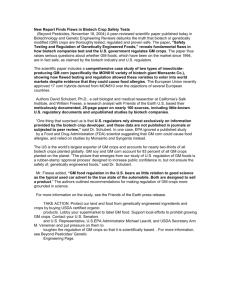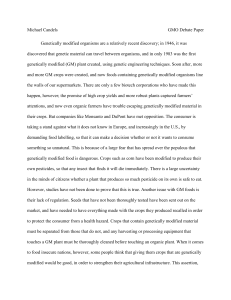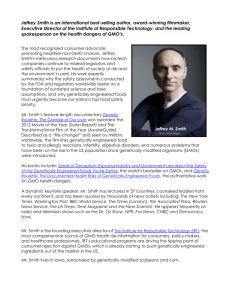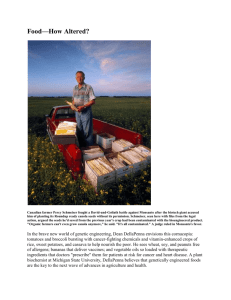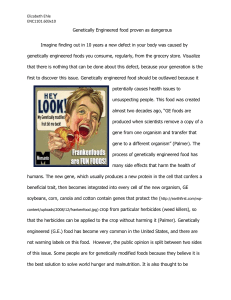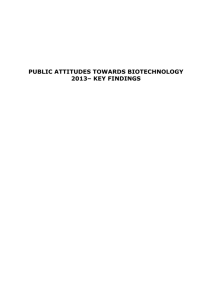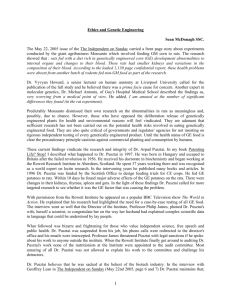Original Mediation Essay
advertisement
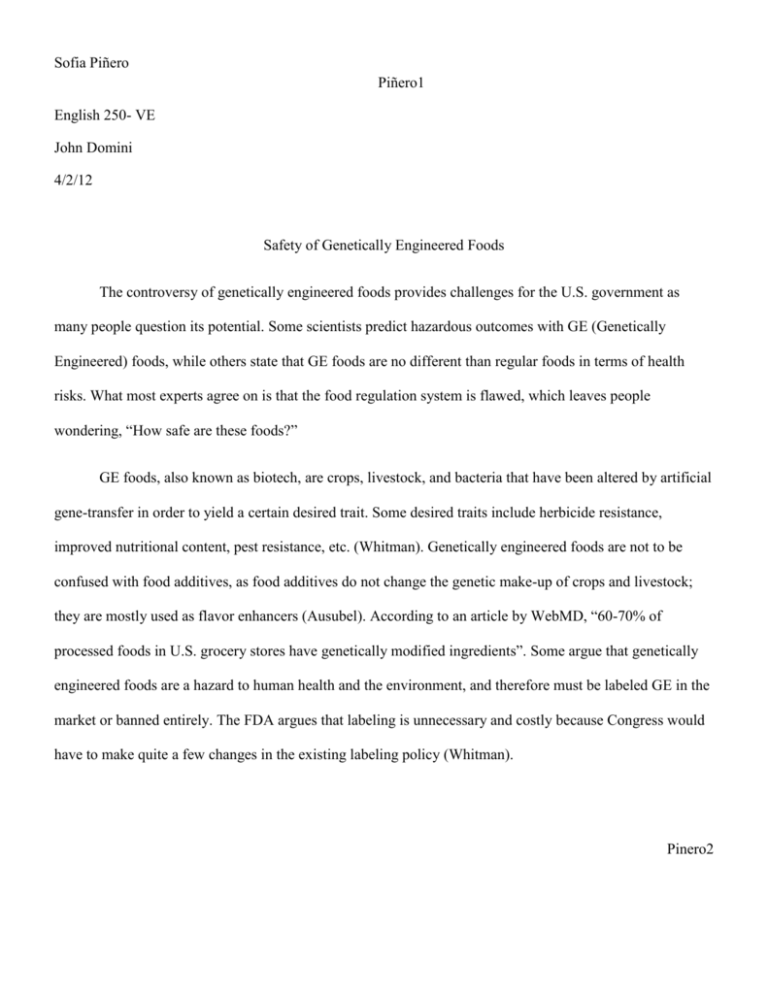
Sofia Piñero Piñero1 English 250- VE John Domini 4/2/12 Safety of Genetically Engineered Foods The controversy of genetically engineered foods provides challenges for the U.S. government as many people question its potential. Some scientists predict hazardous outcomes with GE (Genetically Engineered) foods, while others state that GE foods are no different than regular foods in terms of health risks. What most experts agree on is that the food regulation system is flawed, which leaves people wondering, “How safe are these foods?” GE foods, also known as biotech, are crops, livestock, and bacteria that have been altered by artificial gene-transfer in order to yield a certain desired trait. Some desired traits include herbicide resistance, improved nutritional content, pest resistance, etc. (Whitman). Genetically engineered foods are not to be confused with food additives, as food additives do not change the genetic make-up of crops and livestock; they are mostly used as flavor enhancers (Ausubel). According to an article by WebMD, “60-70% of processed foods in U.S. grocery stores have genetically modified ingredients”. Some argue that genetically engineered foods are a hazard to human health and the environment, and therefore must be labeled GE in the market or banned entirely. The FDA argues that labeling is unnecessary and costly because Congress would have to make quite a few changes in the existing labeling policy (Whitman). Pinero2 Those against biotech foods fear antibiotic resistance, creation of a “super weed”, and other accidental adverse effects on crops, animals, and humans. Most of these fears, however, are long term and will not be validated until further testing occurs. As stated earlier, most experts agree that the safety regulation system is flawed. A CSPI (Center for Science in the Public Interest) study found that biotech companies haven’t voluntarily complied with federal regulations in the past. Even Monsanto, an agricultural biotech company, have had errors in their submissions and their products have still made it in grocery stores (“Are Biotech…”). The fear of the “super-weed” stems from crops, like soybeans and canola, engineered to be resistant to herbicides. With herbicide-resistant crops, some scientists fear that there will be an overuse of the glysophate based Round-up herbicide which can be harmful to the environment (Ludwig). The creation of a super-weed has already occurred in the UK and Canada, resulting in no GE foods commercially grown there (Brown). Weeds have large variation in their genetics and are therefore easily adaptable to their surroundings Furthermore, GE pesticide producing crops are also starting to negatively impact the environment. According to Greenpeace, these crops secrete toxins called Bt that have proven to be toxic towards harmless species and even towards beneficial insects. Green lacewings are helpful in keeping the maize pest population under control and are being threatened with the Bt toxin. The lacewings die from the toxins because they eat the infected prey (“Environmental and health...”). Piñero3 One of the most immediate risks with biotech food is the creation and spread of dangerous allergens. When put into a specimen, foreign and engineered proteins can cause allergic reactions in certain people (“Are Biotech…”). In 2000, Starlink modified corn seed(approved by the EPA for animal-consumption only) contaminated Kraft products resulting in massive recalls due to several incidents of allergic reactions (“Are Biotech…”). Supporters of GE foods contend that GE products are no more dangerous than regular food products and contain so many advantages, for both the crops and humans, such as pharmaceuticals, enhanced nuitrition, and resistance to disease, pests, etc. Researchers continue to find innovations in medicine as they try to create edible vaccines for use in third world countries. In March 2012, scientists in Texas A&M have accomplished such a task by genetically engineering a goat to carry a malaria vaccine in her milk (Berkowitz). Injectable vaccines and certain medicines are more difficult to store and spread in third world countries because they require special conditions and a trained professional to prescribe/administer them (Whitman). With the creation of an edible vaccine, transportation costs and storage difficulties would drop. Another benefit to genetic engineering is that it can help reduce hunger and malnutrition around the world. An article by National Geographic addresses the issue of hunger in third world countries: Piñero4 “… between 100 million and 140 million children in the world suffer from vitamin A deficiency, some 500,000 go blind every year because of that deficiency, and half of those children die within a year of losing their sight.” In an attempt to solve this issue, scientists engineered a “golden rice” that contained beta carotene, a building block of vitamin A, for distribution in developing countries (Ackerman). Scientists also genetically engineer crops to grow closer together so farmers can plant more. This results in increased yield of crops, which, in addition to disease and drought resistance, can also be sent to third world countries in the form of a seed. Lastly, supporters of biotech foods contend that there is always the organic option for those who demand labeling on GE food products. The costs labeling would be very high, seeing that 60-70% of products in grocery stores contain a genetically engineered ingredient (Byrne). There is also the concern that if all biotech foods were labeled, people would be less interested in buying due to the stigmas associated with genetic engineering (“Are Biotech…”). In conclusion, the possibilities of genetic engineering are too big to ignore. It is not probable that GE food will be completely banned; however, the fears associated with biotechnology should not be shrugged off. With Monsanto products being rushed for commercial usage without proper testing, there is no guarantee that the GE crops will continue to be harmless in the future. Genetically engineered products should go through a safety test over time so that it can be introduced into markets without future consequence. That would mean stricter federal safety regulations for biotech companies like Monsanto to deter them from any attempts around the system. Piñero5 Works Cited Ackerman, Jennifer. “Altered Food, GMO’s, Genetically Modified Food.” National Science. National Geographic Mag.,May2002.Web.23March2012 Geographic: Ausubel, Warren. "Food Additives and Pesticides." Berkeley Technology Law Journal. California. n.d.Web. 23 Mar. 2012. University of “Are Biotech Foods Safe to Eat?” WebMD, WebMD, LLC., nd. Web.23March2012 Berkowitz, Lana. "Malaria Vaccine in A&M Goats' Milk Could save Lives." Houston Chronicle. Hearst Communications Inc., 3 Mar. 2012. Web. 23 Mar. 2012. Brown, Paul. “GM crops created superweed, say scientists.” The Guardian. Guardian News and Media Limited. 24July2005.Web.23March2012 Byrne, P. "Labeling of Genetically Engineered Foods." Colorado State University Extension. Web. 23 Mar. 2012. “Environmental and health impacts of GM crops- the science.” GreenPeace. n.p. September 2011.Web23March2012 Sept. 2010. Ludwig, Mike. "Feds Approve Monsanto Herbicide-Resistant Crops." Truthout. n.p., 15 Feb. 23 Mar. 2012 Whitman, Deborah. “Genetically Modified Foods: Harmful or Helpful?” (2000): ProQuest. Web. 23March2012 2011. Web. Excellent Good Fair Needs Work Context Position: thoughtful, perceptive definition of central question; scope is sufficiently narrow Purpose: approach overall clarifies mediation purpose X X Substance X Development: sufficient summary and insight about topic; paragraphs focused and yet fully developed Sources: appropriate for topic, pertinent in placement, and accurately cited in text; all quotations introduced correctly X Organization Thesis: a thesis, early or late, that clearly states both sides of question and its mediation Introduction and Conclusion: overview of organization given at the beginning; conclusion sums up key points Relationship: relationship of ideas clear; coherent; transitional devices used to guide reader Unity: all paragraphs contribute to thesis; paragraphs structured around controlling ideas; no tangents Sequence: mediation emerges in a logical order; organization for essay is clear & effective X X X X X Style Style: clear and concise writing; no confusing or awkward writing Sentence structure: sentences varied; subordination and coordination used effectively Vocabulary: precise, vivid and appropriate word choice X Conventions & Correctness free from sentence-level errors free from word-level errors X X X Delivery Visuals: any visuals used are integrated effectively with titles and captions Works Cited: typed Works Cited page attached to each final draft that correctly cites sources Formatting: 1” margins, Times or Times New Roman 12 point font; MLA header; page numbers on pages; double-spaced ____X_Workshopped. / Overall Comments: The X X X improvement in your work this semester is impressive, & especially so in your organization. Your outline overall, here, is the strongest element. The brief transitional ¶s, before the “against” arguments & then the “for,” need work clarifying their purposes, but their placement & the strength of the outline soon enough makes that purpose clear. The “against” side is the weaker of the two, raising accusations without specifics, & there’s awfully little about the labeling issue too. Still, this is solid college research, & the control of mechanics is also admirable. B or 85.
